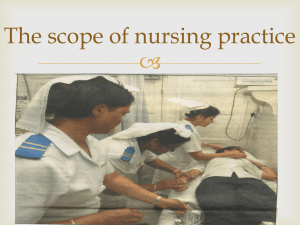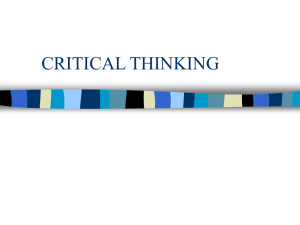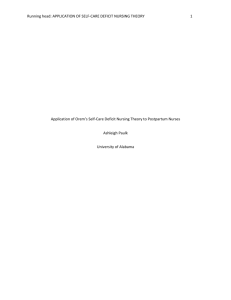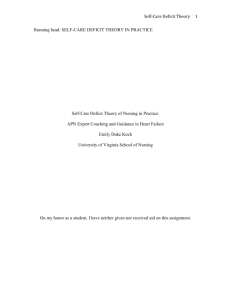Self-Care is Health Care
advertisement
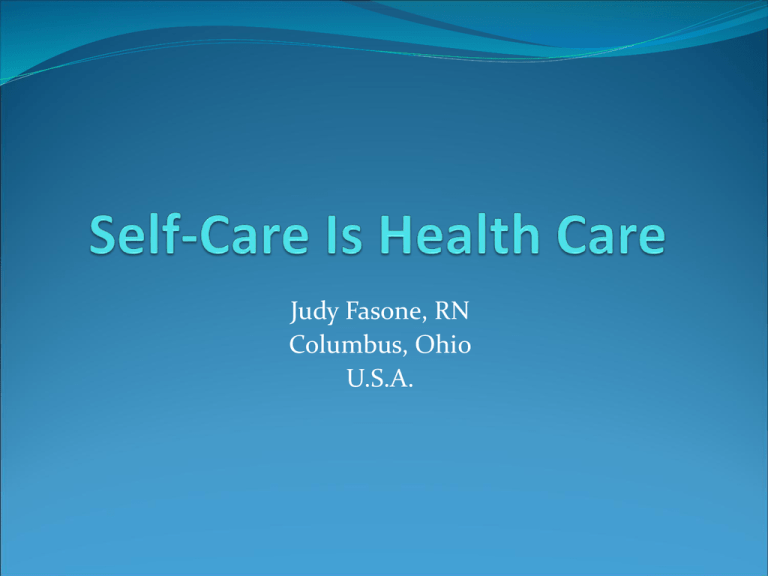
Judy Fasone, RN Columbus, Ohio U.S.A. What is Self-Care Describe your current self-care strategies Describe your current self-care plan Self Care is not selfish! What is Health Care? The Connection between Self-Care and Health Care The way of a leader Self Care Self Love Self Efficacy Self-Efficacy "If I have the belief that I can do it, I shall surely acquire the capacity to do it even if I may not have it at the beginning.“ ~ Mahatma Gandhi ~ Self-love and the discipline of self-care creates the ability to change. How do nurse leaders fit into the current healthcare structure? •Strategic thinker •Facilitative style •Mentors •Coaches •Empowered •Transformational leadership style •Mainly Traditional • Expert in clinical • Many learn to teach while teaching •No holistic Educator certification as yet •Self-care is not evaluated in self or student •SHORTAGE Nurse Leader Traditional Nurse Nurse Educator Holistic Nurse • Specialization • Follows the Dr’s lead • Is the expert • Top-down style of leadership • Horizontal violence between nurses • Generalist • Healed Healer • Relationship focus teambuilder • Coach • Creatively solve problems Current Gaps in Nursing Shortage of nurses Shortage of nurse educators Baby boomers coming of “age” and needing more health care services An aging nursing population Chan and Perry (2009) An unhealthy nursing population Raingruber and Robinson, (2007); Naum et al, (2012) A transient (job) nursing population Do nurses avoid leadership positions? Symbolic Sirius Positive Psychology=Soul food (Muha and Manion, 2010) Staff engagement Camaraderie Teamwork Professionalism Non-linear approach Encourage experiences that create positive experiences Six Principles of Positive Psychology PROPEL (Muha and Manion, 2010) Passion Specific vision with buy in from staff creates energy and redirects away from negative stressors Relationships 5 positive interactions for every negative encounter. Leaders must generate interest in the lives of staff Optimists Problems are described as short term, see the bigger picture, encourage staff to problem solve, appreciate the positive contributions of staff Proactive Use their strengths, takes as good of care of self and staff and patients Energy Continually replenish their own physical self, and encourage staff to care for self Legacy Pursuit of own purpose, upward spiral of growth, all demonstrate a commitment to achieving extraordinary results. PROPEL Statistics (Muha and Manion, 2010) Case study at major academic medical center Poorly functioning department became highly functional within one year Job engagement score rose from 3% to 87% Staff satisfaction 1%-85% Patient satisfaction rose 43% Staff caring increased Positive balance in emotional bank account How then, shall we lead? Transformational leadership is the model needed to develop nursing into an empowered profession with the potential to be a dominant voice in reshaping the healthcare system of the future. (Sofarelli and Brown, 1998) Transformational processes are taught in coaching and some Holistic Nursing Curricula in both undergraduate and graduate nursing programs across the country. Almost ready Nurses Leading Change Samela, Erikson, Fagerstrom (2011) Self Staff • Self love, self-care, self-efficacy (Fasone, 2014) • Leading relationships • Team player, interactive, coach • Leading process Client • Open, confirming, Evidenced Based Atmosphere Org. • Leading a culture • Coodinator, conductor, weave a tapestry Managing Change Sofarelli and Brown (1998) Management of Attention Pay attention to surroundings, live their vision, look for new opportunities to make their vision a reality Management of meaning Charismatic ability to share the vision, making it visible Management of trust The leader is totally reliable and have integrity Management of self High personal self-regard, mistakes are opportunities (Benis,1986) Nurses as Coaches Coaching skills enhance leadership skills SelfReflection Self-Care Williamson (2009) Nurse as Coach SelfEvaluation SelfAssessments Integrative Nurse Coaching Nurse Coaches and clients are engaged in a manner that allows for a shift in consciousness and exploration of the client’s life’s journey, health and wellness goals, healing, and transformation. KEY POINTS theories of change resilience flow positive psychology complexity science psychoneuroimmunology reflective and integrative practices Bloom where you are planted! References Raingruber, B., & Robinson, C. (2007). The effectiveness of tai chi, yoga, meditation and Reiki healing sessions in promoting health and enhancing problem solving abilities of Registered Nurses. Issues of Mental Health Nursing, 28(10), 1141-1155. Naum, E., Warren, J., Zhu, S., An, M., & Brown, J. (2012). Nurses’ self-care behavior related to weight and stress. Nursing Outlook, 60(E23-E31), E23-E31. Chan, C., So, W., & Fong, D. (2009). Nursing students’ stress and their coping strategies in clinical practice. Journal of Professional Nursing, 25, 307-313. Sofarelli, D. and Brown, D. (1998). The need for nursing leadership in uncertain times. Journal of Nursing Management,6,4,201-7. Salmela, S., Eriksson, K., and Fagerstrom, L. (2011). Leading change: a 3 dimensional model of nurse leaders main tasks and roles during a change process. Journal of Advanced Nursing. 423-433. Williams, C., (2009). Using life coaching techniques to enhance leadership skills in nursing. Nursing Times, 1-6. Institute of Medicine. The Future of Nursing: Leading Change, Advancing Health. Washington, DC: The National Academies Press, 2011.







